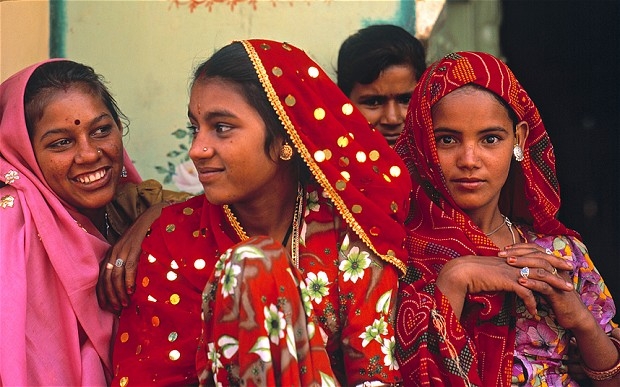The Art of Wearing a Sari

I have aspired to wear a sari for as long as I can remember. It's probably because of years of watching Bollywood films, admiring Indian film heroines such as Aishwarya Rai and Maduri Dixit.
My favorite Bollywood actresses motivated my search for this mesmerizing traditional costume, and continue to inspire me to this day:
"It's extremely sensuous and at the same time it is strong...there is an elegance and at the same time it teases your imagination" -Vidya Balan.
Image Credit: unsplash.comTheir colorful Saris only added to the thrill of their dramatic poses, alluring facial expressions, and passionate film plots - who could forget the classic scene of the two lovers in the rain, when the female protagonist was captured in a colorful and rain-soaked sari in the arms of her man?
Beyond Bollywood galore, the concept of the sari encouraged me to indulge in India's many cultural facets. When I embarked on my journey to India during the winter, I had my first up-close experience with this unique clothing item.
Image Credit: Tara JamaliThe sari is a traditional costume for Indian women, and inspires woman's fashion globally. Its main feature is a long unstitched rectangle cloth from four to nine yards in length, draped around the body in various styles. All Indian women wear Saris regardless of class or caste, although nowadays, the sari is increasingly replaced with Western outfits.
Luckily, in Tamil Nadu, where I stayed, plenty of women still wear it. While sporting a sari all day is not very comfortable, especially for female students or professionals, few clothing items come to mind which embody the essence of femininity like a sari does.
As it turns out, buying a sari is not as easy as it seems! The most popular store in town was located at a considerable distance from my internship site. My colleague was kind enough to offer me a ride on his motorbike. After trying on at least five saris in different colors - which I could not have done without the help of a female employee - I finally settled on a dark pink and turquoise one, with floral patterns.
Image Credit: Tara JamaliThe process of putting the outfit together is complicated, but definitely worth it. Deciding on the lengthy cloth that is wrapped around your body several times is only the first step. One must wear a petticoat underneath, which has to be bought separately and match the base Sari color as closely as possible. The cloth for the tight-fitting short sleeved shirt, that ends just below the bust, must be stitched on separately by a tailor.
Did I mention that nobody at the store spoke English? Thankfully, my colleague translated much of the conversation with both the sari shopkeeper and the tailor. I wore the sari during my last day in India, when I presented my internship project at the local town hall. I hope I'll have another opportunity to wear my sari in the future, such as international events or Indian celebrations.
During my stay I did not see any foreign women wearing a sari, even though some sported less-traditional Indian attire. I believe that an essential part of enjoying a cultural experience like mine is getting accustomed to traditional practices and costumes. An Indian woman, when asked whether she felt the sari would ever become an international drape, said: "You need a lot of patience to wear a sari. It's in our DNA here in India. In the West, women wouldn't understand how to wear and move in a sari...
Me in my sari. Image Credit: Patricia MolinosThe sari is coveted by women on a large scale, even outside its region of origin. Celebrities like Elizabeth Hurley, Jessica Alba, and Fran Drescher have famously worn this kind of attire. On her visit to India, Oprah Winfrey attended a sari fitting for a party, saying, "I really wanted to wear one. I wanted to know that would feel like, I wanted to immerse myself in the Indian culture."
To look and appreciate the Sari even more, one can add bangles, bracelets, earrings, decorative hair accessories, and of course, make-up. In India it is said that accessories are the core of women. The ones I saw on many Indian women, such as gold and silver earrings, necklaces, bracelets and ankle bracelets, adorned their saris harmoniously.
In Tamil Nadu, one of the many customs of wearing a sari include decorating their hair with fragrant jasmine flowers. Every morning, these women would tie flowers in their strands of hair religiously, after a warm bath. Other than the aesthetic beauty, the scent of Jasmine can reduce anxiety and promote well-being according to Ayurvedic tradition. It is also believed that when a woman wears flowers in her hair, it will bring prosperity and happiness to the household.
Tamil Nadu women wearing fresh jasmine in their hair. (Pinterest)Buying the sari in such a uniquely Indian way helped me to experience parts of the Indian culture to its very core. Some may question why as a non-Indian woman, I place so much importance on a traditional Indian costume. I just happen to believe that saris truly expose the beauty of a woman, along with her sensuality.
Because I take pride in my femininity, I am so grateful for having had the chance to purchase an item of clothing that is so unique and timeless. When a woman wears a sari for an occasion, walking in the midst of a party with a smile and her head held high, it displays her subtle yet strong aura of sensibility, along with a sophisticated appreciation of the values of multiculturalism.













